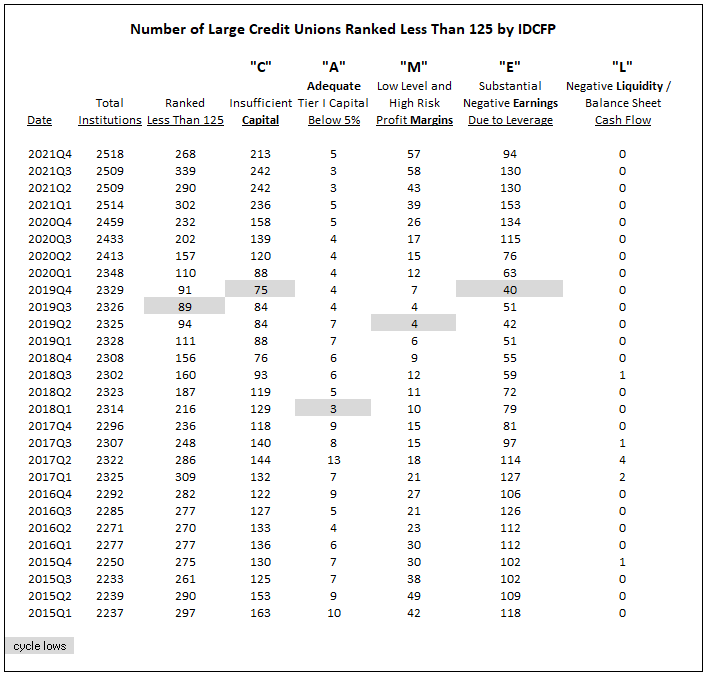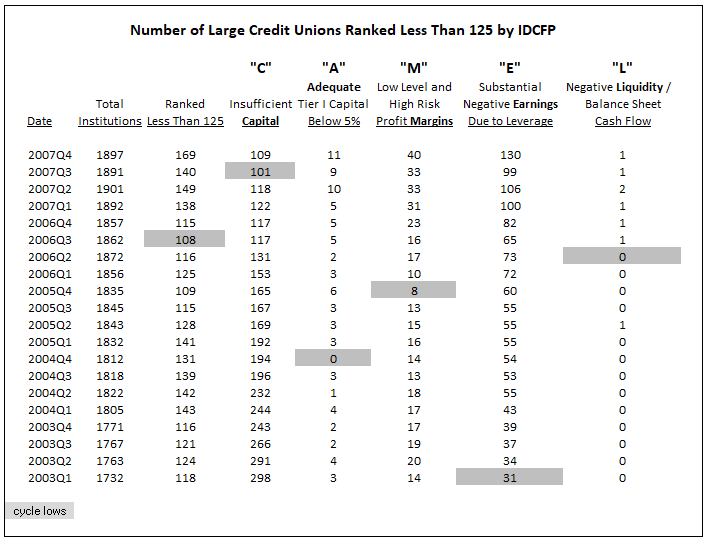Credit Unions are Growing in Numbers and Strength
Credit unions have grown to become a major factor in the U.S. economy, with assets that have grown at nearly twice the pace of banks over the past decade. Credit unions are owned by their members and are designed to offer lower borrowing costs and higher deposit rates. In addition, the median large credit union (greater than $50 million in assets) earned a return on equity (shares and reserves) of 6.0% and experienced 6% loan growth over the past year.
IDC Financial Publishing (IDCFP) focuses on 2,518 credit unions with $50 million or more in assets to determine the risks to the financial system. These larger institutions are using their strength to compete aggressively for business. The group of 2,528 credit unions with assets less than $50 million remain important to the industry, but are not a major risk factor in a potential economic downturn or the overall health of our financial system.
Reduced Risk in Large Credit Unions
IDCFP calculated the CAMEL rating of 5,046 credit unions in the fourth quarter of 2021. The 2,518 large credit unions account for 98% of total credit union assets and remain a potential risk factor in a future major economic downturn.
To determine this risk, we separate the credit unions ranked under 125, which is below-investment-grade and the industry standard. As of the end of the fourth quarter 2021, 268 large credit unions were ranked below 125 by IDCFP, down from a new high of 339 the previous quarter. This peak in institutions seen last quarter was a risk alert, however, that number is declining again, along with institutions with insufficient capital, those with low level and high risk profit margins, and those with substantial negative earnings. Only institutions with less than 5% adequate capital increased, and those with negative liquidity remained at zero (see Table I). To forecast risk in the credit union industry, the total number of institutions, along with all components of CAMEL, must reach a low and subsequently climb in number.
The “C” in CAMEL, which represents insufficient capital reached a low of 75 in the fourth quarter of 2019, peaked at 242 in the last two quarters, but declined to 213 in 2021Q4. The “A” in CAMEL, or adequate Tier 1 capital to meet loan delinquency, reached a low of 3 in 2018Q1, decreased again to 3 in 2021Q2 and 2021Q3, but increased to 5 in 2021Q4. The “M” in CAMEL, which measures operating profit margins with high-risk characteristics, reached a low of 4 institutions in the second quarter of 2019, rose to a peak of 58 last quarter and declined to 57 in 2021Q4. The number of institutions below investment grade under “E” with negative earnings reached a low of 40 in the fourth quarter of 2019, and grew to a high of 153 in 2021Q1, but declined to 94 as of the fourth quarter of 2021 (see Table I).
We have seen increases in many of the components of CAMEL over the previous two quarters, but the total number of institutions, plus most components of CAMEL, have declined as of 2021Q4. Therefore, IDCFP forecasts reduced risk in the credit union industry, but maintains it is important to monitor, as issues related to Covid-19 are resolved and economic recovery continues.
Table I

The Risk Illustrated by IDCFP in 2005 to 2007 Forecast the 2008/2009 Credit Union Crisis
IDC successfully indicated a risk alert for the credit union industry as early as the fourth quarter of 2006, over a year prior to the financial and economic collapse of 2008 and 2009. Out of the 1,862 large credit unions in the third quarter of 2006, 108 were ranked below 125, or less than investment grade. The increase to 115 in the fourth quarter signaled the major risk alert for credit unions.
The “C” in CAMEL bottomed at 117 in the third quarter of 2006, but then recycled when it hit a low of 101 in the third quarter of 2007. The “A” low of zero was in the first quarter of 2005, the “M” low of 8 was in the fourth quarter of 2005, the “E” low of 31 was much earlier, in the first quarter of 2003, and the “L” component of CAMEL was zero in the second quarter of 2006.
In summary, IDCFP’s risk alert for the financial downturn of large credit unions, as well as, the entire credit union industry, was evident in the fourth quarter of 2006, successfully forecasting the financial problem to occur in 2008 and 2009 (see Table II).
Table II

Credit Unions Are Buying Out Banks
Last year there were 13 sales of banks to credit unions. In 2022, there are already 5 and counting.1
The $2.8 billion-asset Arizona Federal Credit Union plans to buy the $540 million-asset Horizon Community Bank for $91.4 million in cash. Arizona Federal also agreed to cover a portion of Horizon Community’s expected federal income tax tied to sale of assets.
Many community banks with assets under $1 billion are closely held as sub chapter S corporations. A family-owned bank without a future management plan, or the means to modernize its technology, may look to sell for cash as an alternative.
1 Record year seen for credit union buyouts of banks
To view our products and services please visit our website. For more information about our CAMEL ratings, or for a copy of this article, please contact us at 800-525-5457 or info@idcfp.com.
John E Rickmeier, CFA
President
jer@idcfp.com
Robin Rickmeier
Marketing Director
